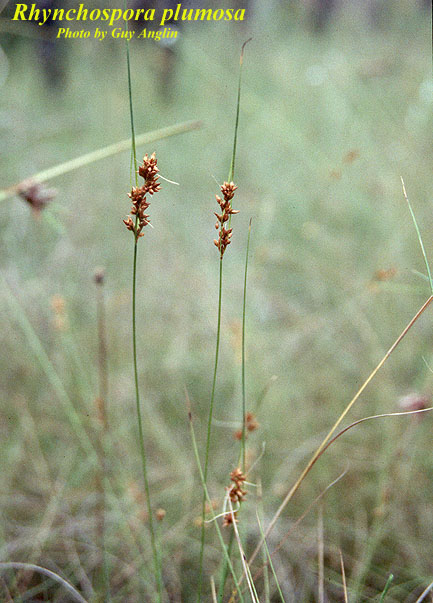Difference between revisions of "Rhynchospora plumosa"
(→Taxonomic notes) |
|||
| Line 38: | Line 38: | ||
===Phenology=== <!--Timing off flowering, fruiting, seed dispersal, and environmental triggers. Cite PanFlora website if appropriate: http://www.gilnelson.com/PanFlora/ --> | ===Phenology=== <!--Timing off flowering, fruiting, seed dispersal, and environmental triggers. Cite PanFlora website if appropriate: http://www.gilnelson.com/PanFlora/ --> | ||
| − | Flowers and fruits April through December.<ref name="FSU Herbarium"/> | + | Flowers and fruits April through December.<ref name="FSU Herbarium"/><ref>Nelson, G. [http://www.gilnelson.com/ PanFlora]: Plant data for the eastern United States with emphasis on the Southeastern Coastal Plains, Florida, and the Florida Panhandle. www.gilnelson.com/PanFlora/ Accessed: 19 MAY 2021</ref> |
<!--===Seed dispersal===--> | <!--===Seed dispersal===--> | ||
Revision as of 09:33, 8 June 2021
| Rhynchospora plumosa | |
|---|---|

| |
| Photo by Guy Anglin, Atlas of Florida Vascular Plants | |
| Scientific classification | |
| Kingdom: | Plantae |
| Division: | Magnoliophyta – Flowering plants |
| Class: | Liliopsida – Monocotyledons |
| Order: | Cyperales |
| Family: | Cyperaceae |
| Genus: | Rhynchospora |
| Species: | R. plumosa |
| Binomial name | |
| Rhynchospora plumosa Elliott | |

| |
| Natural range of Rhynchospora plumosa from USDA NRCS Plants Database. | |
Common name: Plumed beaksedge
Contents
Taxonomic notes
Synonyms: Rynchospora pineticola C.B. Clarke[1]; Rynchospora semiplumosa A. Gray.
Description
A description of Rhynchospora plumosa is provided in The Flora of North America.
Distribution
Ecology
Habitat
In the Coastal Plain in Florida, R. plumosa can occur in savannas, open scrub oak savannas, wiregrass savannas, pine-palmetto scrub oaks, seasonally wet depressions in open pinewoods, pine flatwoods, regularly burned pine flatwoods, slash pine-wiregrass flatwoods, exposed sandy bottoms of lakes, seepages slopes, hillside bogs, grass-sedge bogs, shrubby borders of depression marshes, sand ridges, mangrove swamps, dry pine barrens, and drying ephemeral ponds.[2] It can also be found in power line corridors, sandy roadsides, wet borrow pits, shrub bog clearings, pine flatwood clearings, moist roadside depressions, cut-over pinewoods, cleared palmetto scrubs, bull-dozed scrublands, boat ramps, pine plantations, and clobbered pine-wiregrass flatwoods. Soils include dry sand, moist sandy peat, loamy sand, sandy loam, and white sand.[2]
R. plumosa was found in non-disturbed longleaf pine sites in the North Carolina; in contrast, the species was not found in highly disturbed sites.[3] It responds negatively to soil disturbance by heavy silvilculture in North Carolina.[4]
Associated species include Aristida stricta, Pinus palustris, Serenoa repens, Hypericum, Stillingia, Xyris, Rhexia mariana, Dichanthelium wrightianum, Scleria georgiana, Sarracenia flava, Drosera, Sarracenia, Rhynchospora elliottii, R. corniculata, R. chapmannii, R. pusilla, R. fascicularis, R. baldwinii, R. globularis, R. wrightiana, R. fernaldii, and R. ciliaris.[2]
Rhynchospora plumosa is frequent and abundant in the Lower Panhandle Savannas community type as described in Carr et al. (2010).[5]
Phenology
Flowers and fruits April through December.[2][6]
Fire ecology
In longleaf pine forests of the southeastern United States, R. plumosa benefits from higher fire fequencies and is common in the second winter after after a fire.[7][8]
Use by animals
The Henslow’s Sparrow (Ammodramus henslowii) does not prefer to eat the seeds.[8]
Conservation and management
Cultivation and restoration
Photo Gallery
References and notes
- ↑ Weakley, A.S. 2015. Flora of the southern and mid-atlantic states. Working Draf of 21 May 2015. University of North Carolina at Chapel Hill, Chapel Hill, North Carolina.
- ↑ 2.0 2.1 2.2 2.3 Florida State University Robert K. Godfrey Herbarium database. URL: http://herbarium.bio.fsu.edu. Last accessed: July 2015. Collectors: Loran C. Anderson, Robert K. Godfrey, S. F. Blake, Robert Kral, Mabel Kral, A. F. Clewell, Robert Blaisdell, Ann F. Johnson, Sidney McDaniel, Kurt E. Blum, S.L. Orzell, Edwin L. Bridges, H. E. Grelen, P. L. Redfearn, Edward Wheeler, S. M. Tracy, N. C. Henderson, Cecil R. Slaughter, M. Minno, Austin R. Mast, O. Lakela, A. H. Curtiss, Chris Buddenhagen, Becky Bee, Annie Schmidt. States and Counties: Florida: Alachua, Bay, Bradford, Calhoun, Citrus, Collier, Dixie, Duval, Flagler, Franklin, Gulf, Hernando, Lee, Leon, Levy, Liberty, Martin, Nassau, Okaloosa, Orange, Osceola, Pasco, Pinellas, Polk, Santa Rosa, St. Johns, Sumter, Taylor, Volusia, Wakulla, Walton, Washington. Compiled by Tall Timbers Research Station and Land Conservancy.
- ↑ Cohen, S., R. Braham and F. Sanchez. 2004. Seed bank viability in disturbed longleaf pine sites. Restoration Ecology 12:503-515.
- ↑ Cohen, S., R. Braham, and F. Sanchez. (2004). Seed Bank Viability in Disturbed Longleaf Pine Sites. Restoration Ecology 12(4):503-515.
- ↑ Carr, S.C., K.M. Robertson, and R.K. Peet. 2010. A vegetation classification of fire-dependent pinelands of Florida. Castanea 75:153-189.
- ↑ Nelson, G. PanFlora: Plant data for the eastern United States with emphasis on the Southeastern Coastal Plains, Florida, and the Florida Panhandle. www.gilnelson.com/PanFlora/ Accessed: 19 MAY 2021
- ↑ Glitzenstein, J. S., D. R. Streng and D. D. Wade. 2003. Fire frequency effects on longleaf pine (Pinus palustris, P.Miller) vegetation in South Carolina and northeast Florida, USA. Natural Areas Journal 23:22-37.
- ↑ 8.0 8.1 DiMiceli, J. K., P. C. Stouffer, E. I. Johnson, C. Leonardi and E. B. Moser. 2007. Seed preferences of wintering Henslow's sparrows. Condor 109:595-604.